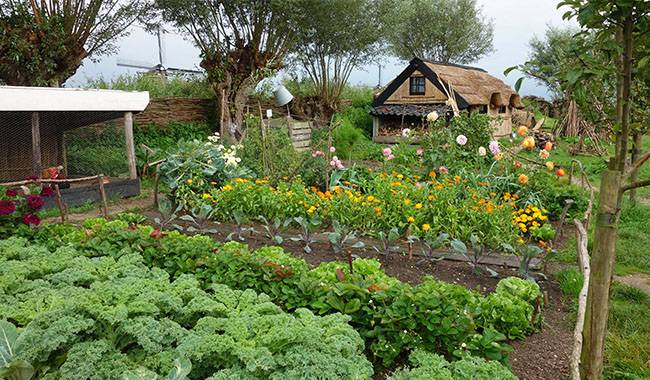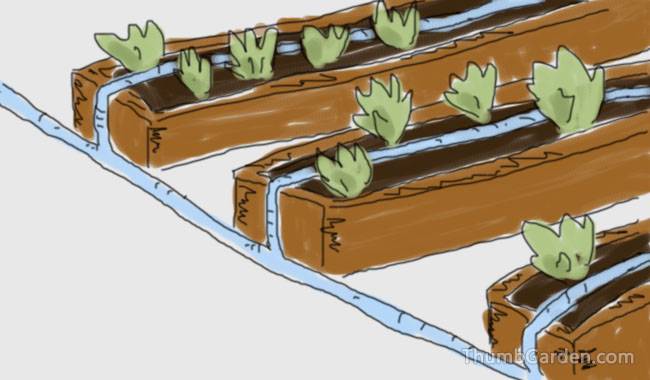
Perhaps one of the hardest things to do is to farm the land. Especially if you intend to get a decent crop, then for more than six months you have to actually live in bed and work hard.
Of course, garden equipment now greatly facilitates the work of gardeners and vegetable farmers, but it is thought that vegetable growers and part-time science Dr. Jacob R. Mittleider offer a slightly different approach, a “Mittleider Gardening” method.
WHAT IS MITTLEIDER GARDENING?
This method is not new, it was first introduced to the inhabitants of our country, even as a subscriber to various magazines and newspapers, where it was actively and thoroughly reported. After reading about the essence of the method, many people were eager to experiment with it on their own plots.
Jacob R. Mittleider himself positioned his method as an effective growing technique, which allowed to grow such a quantity of vegetables in an area of 1.5-200 square meters, which is sufficient for a complete family consisting of four or even five people for the whole year.
The most interesting aspect of this method is that initially the quality of the soil was not taken into account at all, that is to say, not at all so that there was nothing decisive in terms of obtaining yields.
As Jacob R. Mittleider himself advocated, it is acceptable to grow vegetables on “empty” soils, soils that are overgrown with weeds between the rows, soils that are the poorest and completely lacking infertility.
THE BASIC PRINCIPLES OF MITTLEIDER GARDENING.
First, apply mineral fertilizers in stages, second, plant compacted on very narrow ridges, third, always space the rows widely, fourth, use two fertilizer formulas, and of course, strict adherence to these principles is the fifth element of success.
FERTILIZER MIXTURES SUGGESTED BY JACOB R. MITTLEIDER
The first fertilizer mixture should consist of 8 grams of boric acid and 1 kilogram of gypsum (for alkaline soils) according to this method. For acidic soils, gypsum should be replaced by quicklime or, better, dolomite powder.
The second ingredient should be prepared from the base and it must consist of 11 parts of nitrogen, 6 parts of phosphorus, 11 parts of potassium, and some additional ingredients. The additional ingredients include 450 grams of magnesium sulfate, 10 grams of boric acid, and 15 grams of ammonium molybdate. All these must be well mixed and added to the base (in the fertilizer), whose mass should be equal to three kilograms.
Mittlider allows the use of two types of fertilizer application – dry and soluble. When dry, simply spread the fertilizer around the plants, if the distance between plants is 12-20inch (30-50 cm), or between rows, if it is less than 12inch (30 cm).
When you apply to dissolve fertilizer, you simply sprinkle it on the bed, being careful not to get it on the plants themselves. Typically, according to Mittleider, exactly 66 liters of water are needed to dissolve 600 grams of the second mixture for every 30 foot (9 m) of bed.
JACOB R. MITTLEIDER SOIL CULTIVATION OPTIONS
In addition to the suggested fertilizer mixtures, two other options for cultivating soil are offered – cultivating vegetables in open natural soil, and the following methods – cultivating in bed crops that must be filled with special mixtures.
Narrow beds
It involves cultivating plants in narrow beds, which are placed directly on the over-tilled soil. The width of these beds should not exceed 18inch (45cm), but the length can be absolutely anything, limited only by the size of your plot, the shape of your landscape, etc.
In addition, all plantings in these rather narrow beds differ from traditional vegetable crop plantings due to their density. It is envisioned that vegetable crops will receive the necessary light and sufficient water as long as they are planted in wide-spaced rows. By the way, according to Mittlaider, the width between rows should be no less than 30inch (75 cm).
One gets the impression that the success of this method is based on row spacing: if the rows are narrowed, the plants immediately lack light and water because, due to the compact planting pattern, they will inevitably overgrow in the narrow beds, start shading each other and compete for these two important components (light and water).
Obviously, this method was most likely developed for owners of small plots of land and it suits them as best as possible. This seems simple enough, but there are nuances to observe beyond the wide row spacing and narrow beds.
For example, these very beds must be oriented from north to south and never moved from one place to another. Also, you can forget about seedbeds, you shouldn’t even dig them, but it is necessary to weed – not until the weeds are clean, but still to get rid of the strongest weeds.
What about the depletion of the soil and the accumulation of pests and diseases, you ask? To solve all these problems at once, Jacob R. Mittleider suggests using the crop rotation we are all familiar with.
The beds are prepared for planting, starting with fertilization (after digging). Therefore, make one kilogram of the first mixture and half a kilogram of the second mixture (as shown in the picture) on a standard bed of 33 feet (10 meters) in length and 30inch (45 cm) in width.
Next, sow the seeds of the crop you want and, a week after the first shoots appear on the surface of the soil, re-nourish the second batch of the mixture, but already take about 220 grams in the bed. The mixture is spread exactly in the middle of the bed, right between the plants, trying not to touch them. Next, the soil is watered, the fertilizer is absorbed into the soil, and then the nutrients reach the roots.
The amount of fertilizer for just one season, depending on the culture grown in such a bed can vary from three to eight, taking into account, of course, the state of the plants – if they are growing well, then the amount of fertilizer can be reduced.
For example, crops such as radishes, peas, beets, and beans can be fed only three times a season, while eggplant crops (potatoes, tomatoes, etc.), as well as cucumbers and pumpkins, need to be fed seven or eight times a season.
About growing vegetables: In such beds, they are sown in two rows, and if the plants are large you can either sow them in parallel or staggered (cabbage, potatoes, and others).
The distance between plants varies a lot. So, leave half a meter between the baby carrots and the kohlrabi, about 14inch (35 cm) between the cabbage and the lettuce, 6-7inch (17-18 cm) between the cucumbers, 12-14inch (30-35 cm) between the peppers and the eggplants, 10inch (25 cm) between the potato plants, between the onions and the garlic 2inch (5 cm), and the same amount between beets. Crops such as radishes, lettuce, turnips, carrots, and turnips are planted in bands of 1.2-1.5inch (3-4 cm).

Box seedbeds
The next option suggested by Jacob R. Mittleider is to grow vegetables in a substrate, actually in a box that acts as a bed. Box beds can be made of anything, such as wooden planks or plywood.
The bottom of such seedbed soil is not needed, they should be 18inch (45 cm) or 48inch (120 cm) or 60inch (150 cm) wide and about 8inch (20 cm) deep. Such a frame can be placed in a place where you are more comfortable, but certainly not in the shade or in a swamp, filling it with a specially prepared mixture.
The mixture consists of two, at most three parts, namely sawdust (any hardwood), moss (sphagnum soil) and perlite of your choice, river sand, straw (cut very fine), nutshells (also cut very fine), and sunflower seed shells.
If we convert all these into percentage ratios, we get the following picture: about 20% will be sand (perlite or something else of choice) and 40% will be made up of the other two components (sawdust and moss). This structure, which can only be called soil by convention, is placed in a box once and for all, i.e. without changing it anymore and without using any additional soil.
Before sowing seeds in such boxes, you must fertilize the beds. In the smallest box 350x40x8inch (9x1x0.2m) put 4.5 kg of the first mixture and 2.5 kg of the second mixture (whose composition as described above), evenly distributed over the whole area, and then water it heavily.
Next, everything in the box, very carefully mixed, is simply a homogeneous mass, leveled and watered again (several buckets of water). Next, the seeds are sown in trenches in the box, with the distance between the trenches and the plants as specified above for open beds.
All that remains is to fill the seeds to a depth of about 0.6inch (1.5 cm), cover them with the same composition and water again (a bucket and a half of water). The next day, the second application of fertilizer is made directly on the sown seeds, with 600 grams of fertilizer, based on a bed length of 30 feet (9 meters), on which we calculate.
Further applications of fertilizer are made every ten days, at the same rate.
Advantages and disadvantages of the Mittleider Gardening method
Finally, a few words about the advantages and disadvantages of this method of gardening from gardeners who have tried it.
ABOUT THE DISADVANTAGES
Almost everyone is intimidated by a large amount of fertilizer, which is probably the main disadvantage.
The second disadvantage is, as gardeners believe, the need for a lot of water, which is an additional cost and manual labor and finances (you will have to pay for the water).
The third disadvantage also applies to fertilizers, but already on the financial side, ie – how much will cucumbers cost if you use very large amounts of fertilizer?
ABOUT THE ADVANTAGES
Vegetable growers say that Jacob R. Mittleider’s method is very well thought out and does favor manual labor, especially if a person is no longer young or if his time is mediocre enough for vegetables to come from his garden beds.
The advantage is that the plots are properly divided and the plants are at a normal distance from each other, saving soil, while the yield per unit of soil can be increased up to 40 kg, depending on the size of the site.
Vegetable growers like the wide aisles between beds and do not need to make beds every time in the new place, and in fact do not need to take care of the middle row.
As narrow seedbeds can be sown in advance, building a small curved greenhouse, here again, helps with wide row spacing.
As for the box beds, there are some advantages on substandard soil, this is almost the only way to get at least some kind of harvest.
In general, if we exclude the introduction of a significant amount of fertilizer, which Mittlinder recommends, then his method of growing vegetables is only spoken of positively.







